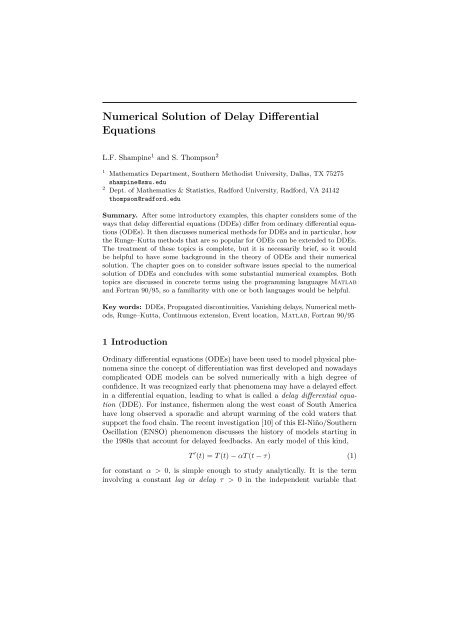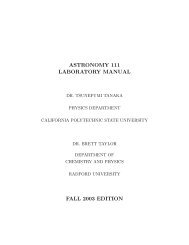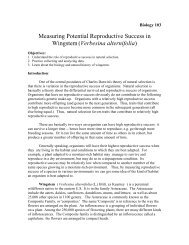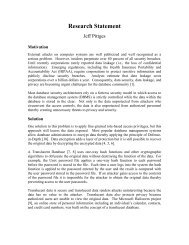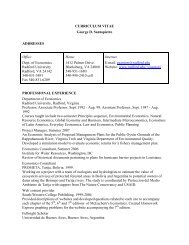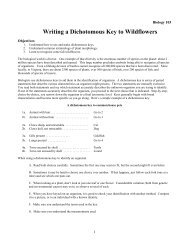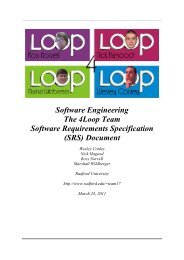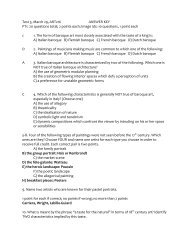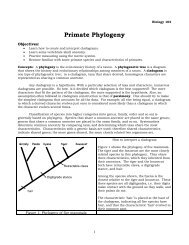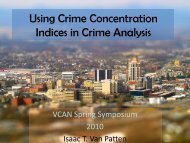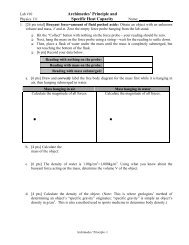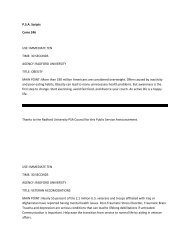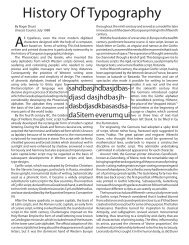Solving Delay Differential Equations - Radford University
Solving Delay Differential Equations - Radford University
Solving Delay Differential Equations - Radford University
Create successful ePaper yourself
Turn your PDF publications into a flip-book with our unique Google optimized e-Paper software.
Numerical Solution of <strong>Delay</strong> <strong>Differential</strong><br />
<strong>Equations</strong><br />
L.F. Shampine 1 and S. Thompson 2<br />
1<br />
Mathematics Department, Southern Methodist <strong>University</strong>, Dallas, TX 75275<br />
shampine@smu.edu<br />
2<br />
Dept. of Mathematics & Statistics, <strong>Radford</strong> <strong>University</strong>, <strong>Radford</strong>, VA 24142<br />
thompson@radford.edu<br />
Summary. After some introductory examples, this chapter considers some of the<br />
ways that delay differential equations (DDEs) differ from ordinary differential equations<br />
(ODEs). It then discusses numerical methods for DDEs and in particular, how<br />
the Runge–Kutta methods that are so popular for ODEs can be extended to DDEs.<br />
The treatment of these topics is complete, but it is necessarily brief, so it would<br />
be helpful to have some background in the theory of ODEs and their numerical<br />
solution. The chapter goes on to consider software issues special to the numerical<br />
solution of DDEs and concludes with some substantial numerical examples. Both<br />
topics are discussed in concrete terms using the programming languages Matlab<br />
and Fortran 90/95, so a familiarity with one or both languages would be helpful.<br />
Key words: DDEs, Propagated discontinuities, Vanishing delays, Numerical methods,<br />
Runge–Kutta, Continuous extension, Event location, Matlab, Fortran 90/95<br />
1 Introduction<br />
Ordinary differential equations (ODEs) have been used to model physical phenomena<br />
since the concept of differentiation was first developed and nowadays<br />
complicated ODE models can be solved numerically with a high degree of<br />
confidence. It was recognized early that phenomena may have a delayed effect<br />
in a differential equation, leading to what is called a delay differential equation<br />
(DDE). For instance, fishermen along the west coast of South America<br />
have long observed a sporadic and abrupt warming of the cold waters that<br />
support the food chain. The recent investigation [10] of this El-Niño/Southern<br />
Oscillation (ENSO) phenomenon discusses the history of models starting in<br />
the 1980s that account for delayed feedbacks. An early model of this kind,<br />
T ′ (t) = T (t) − αT (t − τ) (1)<br />
for constant α > 0, is simple enough to study analytically. It is the term<br />
involving a constant lag or delay τ > 0 in the independent variable that
2 L.F. Shampine and S. Thompson<br />
makes this a DDE. An obvious distinction between this DDE and an ODE is<br />
that specifying the initial value T (0) is not enough to determine the solution<br />
for t ≥ 0; it is necessary to specify the history T (t) for −τ ≤ t ≤ 0 for the<br />
differential equation even to be defined for 0 ≤ t ≤ τ. The paper [10] goes on<br />
to develop and study a more elaborate nonlinear model with periodic forcing<br />
and a number of physical parameters of the form<br />
h ′ (t) = −a tanh[κh(t − τ))] + b cos(2πωt) (2)<br />
These models exemplify DDEs with constant delays. The first mathematical<br />
software for solving DDEs is dmrode [17], which did not appear until 1975.<br />
Today a good many programs that can solve reliably first order systems of<br />
DDEs with constant delays are available, though the paper [10] makes clear<br />
that even for this relatively simple class of DDEs, there can be serious computational<br />
difficulties. This is not just a matter of developing software, rather<br />
that DDEs have more complex behavior than ODEs. Some numerical results<br />
for (2) are presented in §4.1.<br />
Some models have delays τj(t) that depend on time. Provided that the delays<br />
are bounded away from zero, the models behave similarly to those with<br />
constant delays and they can be solved with some confidence. However, if<br />
a delay goes to zero, the differential equation is said to be singular at that<br />
time. Such singular problems with vanishing delays present special difficulties<br />
in both theory and practice. As a concrete example of a problem with<br />
two time–dependent delays, we mention one that arises from delayed cellular<br />
neural networks [31]. The fact that the delays are sometimes very small and<br />
even vanish periodically during the integration makes this a relatively difficult<br />
problem.<br />
y ′ 1(t) = −6y1(t) + sin(2t)f(y1(t)) + cos(3t)f(y2(t))<br />
<br />
<br />
1 + cos(t)<br />
+ sin(3t)f y1 t − + sin(t)f<br />
2<br />
+4 sin(t)<br />
y ′ 2(t) = −7y2(t) + cos(t)<br />
f(y1(t)) +<br />
3<br />
cos(2t)<br />
f(y2(t))<br />
<br />
<br />
2<br />
<br />
1 + cos(t)<br />
+ cos(t)f y1 t − + cos(2t)f<br />
2<br />
+2 cos(t)<br />
y2<br />
y2<br />
<br />
t −<br />
<br />
t −<br />
<br />
1 + sin(t)<br />
2<br />
<br />
1 + sin(t)<br />
2<br />
Here f(x) = (|x + 1| − |x − 1|)/2. The problem is defined by this differential<br />
equation and the history y1(t) = −0.5 and y2(t) = 0.5 for t ≤ 0. A complication<br />
with this particular example is that there are time–dependent impulses,<br />
but we defer discussion of that issue to §4.3 where we solve it numerically<br />
as in [6]. Some models have delays that depend on the solution itself as well<br />
as time, τ(t, y). Not surprisingly, it is more difficult to solve such problems<br />
because only an approximation to the solution is available for defining the<br />
delays.
Numerical Solution of <strong>Delay</strong> <strong>Differential</strong> <strong>Equations</strong> 3<br />
Now that we have seen some concrete examples of DDEs, let us state more<br />
formally the equations that we discuss in this chapter. In a first order system<br />
of ODEs<br />
y ′ (t) = f(t, y(t)) (3)<br />
the derivative of the solution depends on the solution at the present time t.<br />
In a first order system of DDEs the derivative also depends on the solution at<br />
earlier times. As seen in the extensive bibliography [2], such problems arise in<br />
a wide variety of fields. In this chapter we consider DDEs of the form<br />
y ′ (t) = f(t, y(t), y(t − τ1), y(t − τ2), . . . , y(t − τk)) (4)<br />
Commonly the delays τj here are positive constants. There is, however, considerable<br />
and growing interest in systems with time–dependent delays τj(t) and<br />
systems with state–dependent delays τj(t, y(t)). Generally we suppose that<br />
the problem is non–singular in the sense that the delays are bounded below<br />
by a positive constant, τj ≥ τ > 0. We shall see that it is possible to adapt<br />
methods for the numerical solution of initial value problems (IVPs) for ODEs<br />
to the solution of initial value problems for DDEs. This is not straightforward<br />
because DDEs and ODEs differ in important ways. <strong>Equations</strong> of the form (4),<br />
even with time– and state–dependent delays, do not include all the problems<br />
that arise in practice. Notably absent are equations that involve a derivative<br />
with delayed argument like y ′ (t − τm) on the right hand side. <strong>Equations</strong> with<br />
such terms are said to be of neutral type. Though we comment on neutral<br />
equations in passing, we study in this chapter just DDEs of the form (4). We<br />
do this because neutral DDEs can have quite different behavior, behavior that<br />
is numerically challenging. Although we cite programs that have reasonable<br />
prospects for solving a neutral DDE, the numerical solution of neutral DDEs<br />
is still a research area.<br />
2 DDEs Are Not ODEs<br />
In this section we consider some of the most important differences between<br />
DDEs and ODEs. A fundamental technique for solving a system of DDEs<br />
is to reduce it to a sequence of ODEs. This technique and other important<br />
methods for solving DDEs are illustrated.<br />
The simple ENSO model (1) is a constant coefficient, homogeneous differential<br />
equation. If it were an ODE, we might solve it by looking for solutions of<br />
the form T (t) = e λt . Substituting this form into the ODE leads to an algebraic<br />
equation, the characteristic equation, for values λ that provide a solution. For<br />
a first order equation, there is only one such value. The same approach can<br />
be applied to DDEs. Here it leads first to<br />
λe λt = −αe λ(t−τ) + e λt<br />
and then to the characteristic equation
4 L.F. Shampine and S. Thompson<br />
λ = −αe −λτ + 1<br />
In contrast to the situation with a first order ODE, this algebraic equation<br />
has infinitely many roots λ. Asymptotic expressions for the roots of large<br />
modulus are derived in [9]. They show that the equation can have solutions<br />
that oscillate rapidly. To make the point more concretely, we consider an<br />
example from [9] for which it is easy to determine the roots analytically, even<br />
with a parameter a, namely the DDE of neutral type<br />
y ′ (t) = y ′ (t − τ) + a(y(t) − y(t − τ)) (5)<br />
Substituting y(t) = e λt into this equation leads to<br />
(λ − a)(1 − e −λτ ) = 0<br />
The two real roots 0 and a are obvious. They correspond to a constant solution<br />
and an exponential solution y(t) = e at , respectively. These solutions<br />
are not surprising because they are like what we might find with an ODE.<br />
However, any λτ leading to a root of unity also provides a solution. Written<br />
in terms of real functions, we find then that there are solutions cos(2πnt/τ)<br />
and sin(2πnt/τ) for any integer n. This is surprising because it is so different<br />
from the behavior possible with an ODE.<br />
These observations about homogeneous DDEs with constant coefficients<br />
and constant delays show that they can have solutions that behave quite<br />
differently from ODEs. The method of steps is a basic technique for studying<br />
DDEs that reduces them to a sequence of ODEs. To show how it goes and to<br />
illustrate other differences between ODEs and DDEs, we solve<br />
y ′ (t) = y(t − 1) (6)<br />
with history S(t) = 1 for t ≤ 0. On the interval 0 ≤ t ≤ 1, the function y(t−1)<br />
in (6) has the known value S(t − 1) = 1 because t − 1 ≤ 0. Accordingly,<br />
the DDE on this interval reduces to the ODE y ′ (t) = 1 with initial value<br />
y(0) = S(0) = 1. We solve this IVP to obtain y(t) = t + 1 for 0 ≤ t ≤ 1.<br />
Notice that the solution of the DDE exhibits a typical discontinuity in its first<br />
derivative at t = 0 because S ′ (0) = 0 = y ′ (0−) and y ′ (0+) = 1. Now that we<br />
know the solution for t ≤ 1, we can reduce the DDE on the interval 1 ≤ t ≤ 2<br />
to an ODE y ′ = (t − 1) + 1 = t with initial value y(1) = 2 and solve this<br />
IVP to find that y(t) = 0.5t 2 + 1.5 on this interval. The first derivative is<br />
continuous at t = 1, but there is a discontinuity in the second derivative. It is<br />
straightforward to see that the solution of the DDE on the interval [k, k +1] is<br />
a polynomial of degree k + 1 and it has a discontinuity of order k + 1 at time<br />
t = k. By a discontinuity of order k + 1 at a time t = t ∗ , we mean that y (k+1)<br />
has a jump there. Fig. 1 illustrates these observations. The upper (continuous)<br />
curve with square markers at integers is the solution y(t) and the lower curve<br />
with circle markers is the derivative y ′ (t). The jump from a constant value of<br />
0 in the derivative for t < 0 to a value of 1 at t = 0 leads to a sharp change in
Numerical Solution of <strong>Delay</strong> <strong>Differential</strong> <strong>Equations</strong> 5<br />
the solution there. The discontinuity propagates to t = 1 where the derivative<br />
has a sharp change and the solution has a less obvious change in its concavity.<br />
The jump in the third derivative at t = 2 is not noticeable in the plot of y(t).<br />
6<br />
5<br />
4<br />
3<br />
2<br />
1<br />
0<br />
−1 −0.5 0 0.5 1 1.5 2 2.5 3<br />
Fig. 1. Solution Smoothing.<br />
In principle we can proceed in a similar way with the general equation (4)<br />
for delays that are bounded away from zero, τj ≥ τ > 0. With the history<br />
function S(t) defined for t ≤ t0, the DDEs reduce to ODEs on the interval<br />
[t0, t0 +τ] because for each j, the argument t−τj ≤ t−τ ≤ t0 and the y(t−τj)<br />
have the known values S(t − τj). Thus, we have an IVP for a system of ODEs<br />
with initial value y(t0) = S(t0). We solve this problem on [t0, t0 + τ] and<br />
extend the definition of S(t) to this interval by taking it to be the solution<br />
of this IVP. Now that we know the solution for t ≤ t0 + τ, we can move on<br />
to the interval [t0 + τ, t0 + 2τ], and so forth. In this way we can see that the<br />
DDEs have a unique solution on the whole interval of interest by solving a<br />
sequence of IVPs for ODEs. As with the simple example there is generally a<br />
discontinuity in the first derivative at the initial point. If a solution of (4) has<br />
a discontinuity at the time t ∗ of order k, then as the variable t moves through<br />
t ∗ + τj, there is a discontinuity in y (k+1) because of the term y(t − τj) in the<br />
DDEs. With multiple delays, a discontinuity at the time t ∗ is propagated to<br />
the times<br />
t ∗ + τ1, t ∗ + τ2, . . . , t ∗ + τk
6 L.F. Shampine and S. Thompson<br />
and each of these discontinuities is in turn propagated. If there is a discontinuity<br />
at the time t ∗ of order k, the discontinuity at each of the times t ∗ + τj is<br />
of order at least k + 1, and so on. This is a fundamental distinction between<br />
DDEs and ODEs: There is normally a discontinuity in the first derivative at<br />
the initial point and it is propagated throughout the interval of interest. Fortunately,<br />
for problems of the form (4) the solution becomes smoother as the<br />
integration proceeds. That is not the case with neutral DDEs, which is one<br />
reason that they are so much more difficult.<br />
Neves and Feldstein [18] characterize the propagation of derivative discontinuities.<br />
The times at which discontinuities occur form a discontinuity tree. If<br />
there is a derivative discontinuity at T , the equation (4) shows that there will<br />
generally be a discontinuity in the derivative of one higher order if for some<br />
j, the argument t − τj(t, y(t)) = T because the term y(t − τj(t, y(t)) has a<br />
derivative discontinuity at T . Accordingly, the times at which discontinuities<br />
occur are zeros of functions<br />
t − τj(t, y(t)) − T = 0 (7)<br />
It is required that the zeros have odd multiplicity so that the delayed argument<br />
actually crosses the previous jump point and in practice, it is always<br />
assumed that the multiplicity is one. Although the statement in [18] is rather<br />
involved, the essence is that if the delays are bounded away from zero and<br />
delayed derivatives are not present, a derivative discontinuity is propagated<br />
to a discontinuity in (at least) the next higher derivative. On the other hand,<br />
smoothing does not necessarily occur for neutral problems nor for problems<br />
with vanishing delays. For constant and time–dependent delays, the discontinuity<br />
tree can be constructed in advance. If the delay depends on the state<br />
y, the points in the tree are located by solving the algebraic equations (7). A<br />
very important practical matter is that the solvers have to track only discontinuities<br />
with order lower than the order of the integration method because the<br />
behavior of the method is not affected directly by discontinuities in derivatives<br />
of higher order.<br />
Multiple delays cause special difficulties. Suppose, for example, that one<br />
delay is 1 and another is 0.001. A discontinuity in the first derivative at the<br />
initial point t = 0 propagates to 0.001, 0.002, 0.003, . . . because of the second<br />
delay. These “short” delays are troublesome, but the orders of the discontinuities<br />
increase and soon they do not trouble numerical methods. However, the<br />
other delay propagates the initial discontinuity to t = 1 and the discontinuity<br />
there is then propagated to 1.001, 1.002, 1.003, . . . because of the second delay.<br />
That is, the effects of the short delay die out, but they recur because of the<br />
longer delay. Another difficulty is that discontinuities can cluster. Suppose<br />
that one delay is 1 and another is 1/3. The second delay causes an initial discontinuity<br />
at t = 0 to propagate to 1/3, 2/3, 3/3, . . . and the first delay causes<br />
it to propagate to t = 1, . . .. In principle the discontinuity at 3/3 occurs at the<br />
same time as the one at 1, but 1/3 is not represented exactly in finite precision<br />
arithmetic, so it is found that in practice there are two discontinuities that
Numerical Solution of <strong>Delay</strong> <strong>Differential</strong> <strong>Equations</strong> 7<br />
are extremely close together. This simple example is an extreme case, but it<br />
shows how innocuous delays can lead to clustering of discontinuities, clearly<br />
a difficult situation for numerical methods.<br />
There is no best way to solve DDEs and as a result, a variety of methods<br />
that have been used for ODEs have been modified for DDEs and implemented<br />
in modern software. It is possible, though awkward in some respects, to adapt<br />
linear multistep methods for DDEs. This approach is used in the snddelm<br />
solver [15] which is based on modified Adams methods [24]. There are a few<br />
solvers based on implicit Runge–Kutta methods. Several are described in [12,<br />
14, 25], including two codes, radar5 and ddesd, that are based on Radau IIA<br />
collocation methods. By far the most popular approach to non–stiff problems<br />
is to use explicit Runge–Kutta methods [3, 13]. Widely used solvers include<br />
archi [21, 22], dde23 [4, 29], ddverk [7, 8], and dde solver [5, 30]. Because the<br />
approach is so popular, it is the one that we discuss in this chapter. Despite<br />
sharing a common approach, the codes cited deal with important issues in<br />
quite different ways.<br />
Before taking up numerical issues and how they are resolved, we illustrate<br />
the use of numerical methods by solving the model (1) over [0, 6] for α =<br />
2 and τ = 1 with two history functions, T (t) = 1 − t and T (t) = 1. By<br />
exploiting features of the language, the Matlab solvers dde23 and ddesd<br />
and the Fortran 90/95 solver dde solver make it nearly as easy to solve<br />
DDEs as ODEs. Because of this and because we are very familiar with them,<br />
we use these solvers for all our numerical examples. A program that solves<br />
the DDE (1) with both histories and plots the results is<br />
function Ex1<br />
lags = 1; tspan = [0 6];<br />
sol1 = dde23(@dde,lags,@history,tspan);<br />
sol2 = dde23(@dde,lags,1,tspan);<br />
tplot = linspace(0,6,100);<br />
T1 = deval(sol1,tplot);<br />
T2 = deval(sol2,tplot);<br />
% Add linear histories to the plots:<br />
tplot = [-1 tplot]; T1 = [1 T1]; T2 = [2 T2];<br />
plot(tplot,T1,tplot,T2,0,1,’o’)<br />
%--Subfunctions--------------------function<br />
dydt = dde(t,T,Z)<br />
dydt = T - 2*Z;<br />
function s = history(t)<br />
s = 1 - t;<br />
The output of this program is displayed as Fig. 2. Although Matlab displays<br />
the output in color, all the figures of this chapter are monochrome. Except<br />
for the additional information needed to define a delay differential equation,<br />
solving a DDE with constant delays using dde23 is nearly the same as solving<br />
an ODE with ode23. The first argument tells the solver of the function for
8 L.F. Shampine and S. Thompson<br />
evaluating the DDEs (4). The lags argument is a vector of the lags τ1, . . . , τk.<br />
There is only one lag in the example DDE, so the argument is here a scalar.<br />
The argument tspan specifies the interval [t0, tf ] of interest. Unlike the ODE<br />
solvers of Matlab, the DDE solvers require that t0 < tf . The third argument<br />
is a function for evaluating the history, i.e., the solution for t ≤ t0. A<br />
constant history function is so common that the solver allows users to supply<br />
a constant vector instead of a function and that was done in computing the<br />
second solution. The first two arguments of the function for evaluating the<br />
DDEs is the same as for a system of ODEs, namely the independent variable<br />
t and a column vector of dependent variables approximating y(t). Here the<br />
latter is called T and is a scalar. A challenging task for the user interface is<br />
to accomodate multiple delays. This is done with the third argument Z which<br />
is an array of k columns. The first column approximates y(t − τ1) with τ1<br />
defined as the first delay in lag. The second column corresponds to the second<br />
delay, and so forth. Here there is only one delay and only one dependent<br />
variable, so Z is a scalar. A notable difference between dde23 and ode23 is<br />
the output, here called sol. The ODE solvers of Matlab optionally return<br />
solutions as a complex data structure called a structure, but that is the only<br />
form of output from the DDE solvers. The solution structure sol1 returned<br />
by the first integration contains the mesh that was selected as the field sol1.x<br />
and the solution at these points as the field sol1.y. With this information<br />
the first solution can be plotted by plot(sol1.x,sol1.y). Often this is satisfactory,<br />
but this particular problem is so easy that values of the solution<br />
at mesh points alone does not provide a smooth graph. Approximations to<br />
the solution can be obtained anywhere in the interval of interest by means of<br />
the auxiliary function deval. In the example program the two solutions are<br />
approximated at 100 equally spaced points for plotting. A marker is plotted<br />
at (0, T (0)) to distinguish the two histories from the corresponding computed<br />
solutions of (1). The discontinuity in the first derivative at the initial point is<br />
clear for the history T (t) = 1, but the discontinuity in the second derivative<br />
at t = 1 is scarcely visible.<br />
3 Numerical Methods and Software Issues<br />
The method of steps and modifications of methods for ODEs can be used<br />
to solve DDEs. Because they are so popular, we study in this chapter only<br />
explicit Runge–Kutta methods. In addition to discussing basic algorithms, we<br />
take up important issues that arise in designing software for DDEs.<br />
3.1 Explicit Runge–Kutta Methods<br />
Given yn ≈ y(tn), an explicit Runge–Kutta method for a first order system<br />
of ODEs (3) takes a step of size hn to form yn+1 ≈ y(tn+1) at tn+1 = tn + hn<br />
as follows. It first evaluates the ODEs at the beginning of the step,
25<br />
20<br />
15<br />
10<br />
5<br />
0<br />
−5<br />
Numerical Solution of <strong>Delay</strong> <strong>Differential</strong> <strong>Equations</strong> 9<br />
−10<br />
−1 0 1 2 3 4 5 6<br />
Fig. 2. The Simple ENSO Model (1) for Two Histories.<br />
and then for j = 2, 3, . . . , s forms<br />
It finishes with<br />
yn,j = yn + hn<br />
yn,1 = yn, fn,1 = f(tn, yn,1)<br />
j−1<br />
βj,kfn,k, fn,j = f(tn + αjhn, yn,j)<br />
k=1<br />
yn+1 = yn + hn<br />
s<br />
k=1<br />
γkfn,k<br />
The constants s, βj,k, αj, and γk are chosen to make yn+1 an accurate approximation<br />
to y(tn+1). The numerical integration of a system of ODEs starts<br />
with given initial values y0 = y(t0) and then forms a sequence of approximations<br />
y0, y1, y2, . . . to the solution at times t0, t1, t2, . . . that span the interval<br />
of interest, [t0, tf ]. For some purposes it is important to approximate the solution<br />
at times t that are not in the mesh when solving a system of ODEs,<br />
but this is crucial to the solution of DDEs. One of the most significant developments<br />
in the theory and practice of Runge–Kutta methods is a way to<br />
approximate the solution accurately and inexpensively throughout the span<br />
of a step, i.e., anywhere in [tn, tn+1]. This is done with a companion formula<br />
called a continuous extension.<br />
A natural and effective way to solve DDEs can be based on an explicit<br />
Runge–Kutta method and the method of steps. The first difficulty is that in
10 L.F. Shampine and S. Thompson<br />
taking a step, the function f must be evaluated at times tn + αjhn, which<br />
for the delayed arguments means that we need values of the solution at times<br />
(tn + αjhn) − τm which may be prior to tn. Generally these times do not coincide<br />
with mesh points, so we obtain the solution values from an interpolant.<br />
For this purpose linear multistep methods are attractive because the popular<br />
methods all have natural interpolants that provide accurate approximate<br />
solutions between mesh points. For other kinds of methods it is natural to<br />
use Hermite interpolation for this purpose. However, though formally correct<br />
as the step size goes to zero, the approach does not work well with Runge–<br />
Kutta methods. That is because these methods go to considerable expense<br />
to form an accurate approximation at the end of the step and as a corollary,<br />
an efficient step size is often too large for accurate results from direct interpolation<br />
of solution and first derivative at several previous steps. Nowadays<br />
codes based on Runge–Kutta formulas use a continuous extension of the basic<br />
formula that supplements the function evaluations formed in taking the step<br />
to obtain accurate approximations throughout [tn, tn+1]. This approach uses<br />
only data from the current interval. With any of these approaches we obtain a<br />
polynomial interpolant that approximates the solution over the span of a step<br />
and in aggregate, the interpolants form a piecewise–polynomial function that<br />
approximates y(t) from t0 to the current tn. Care must be taken to ensure<br />
that the accuracy of the interpolant reflects that of the basic formula and<br />
that various polynomials connect at mesh points in a sufficiently smooth way.<br />
Details can be found in [3] and [13]. It is important to appreciate that interpolation<br />
is used for other purposes, too. We have already seen it used to get<br />
the smooth graph of Fig. 2. It is all but essential when solving (7). Capable<br />
solvers also use interpolation for event location, a matter that we discuss in<br />
§3.3.<br />
Short delays arise naturally and as we saw by example in §1, it may even<br />
happen that a delay vanishes. If no delayed argument occurs prior to the<br />
initial point, the DDE has no history, so it is called an initial value DDE.<br />
A simple example is y ′ (t) = y(t 2 ) for t ≥ 0. A delay that vanishes can lead<br />
to quite different behavior—the solution may not extend beyond the singular<br />
point or it may extend, but not be unique. Even when the delays are all<br />
constant, “short” delays pose an important practical difficulty: Discontinuities<br />
smooth out as the integration progresses, so we may be able to use a step size<br />
much longer than a delay. In this situation an explicit Runge–Kutta formula<br />
needs values of the solution at “delayed” arguments that are in the span<br />
of the current step. That is, we need an approximate solution at points in<br />
[tn, tn+1] before yn+1 has been computed. Early codes simply restrict the<br />
step size so as to avoid this difficulty. However, the most capable solvers<br />
predict a solution throughout [tn, tn+1] using the continuous extension from<br />
the preceding step. They compute a tentative yn+1 using predicted values<br />
for the solution at delayed arguments and then repeat using a continuous<br />
extension for the current step until the values for yn+1 converge. This is a<br />
rather interesting difference between ODEs and DDEs: If the step size is bigger
Numerical Solution of <strong>Delay</strong> <strong>Differential</strong> <strong>Equations</strong> 11<br />
than a delay, a Runge–Kutta method that is explicit for ODEs is generally<br />
an implicit formula for yn+1 for DDEs. The iterative scheme for taking a<br />
step resembles a predictor–corrector iteration for evaluating an implicit linear<br />
multistep method. More details are available in [1, 29].<br />
The order of accuracy of a Runge–Kutta formula depends on the smoothness<br />
of the solution in the span of the step. This is not usually a problem<br />
with ODEs, but we have seen that discontinuities are to be expected when<br />
solving DDEs. To maintain the order of the formula, we have to locate and<br />
step to discontinuities. The popular codes handle propagated discontinuities<br />
in very different ways. The solver dde23 allows only constant delays, so before<br />
starting the integration, it determines all the discontinuities in the interval of<br />
interest and arranges for these points to be included in the mesh t0, t1, . . ..<br />
Something similar can be done if the delays are time–dependent, but this is<br />
awkward, especially if there are many delays. The approach is not applicable<br />
to problems with state–dependent delays. For problems of this generality,<br />
discontinuities are located by solving (7) as the integration proceeds. If the<br />
function (7) changes sign between tn and tn+1, the algebraic equation is solved<br />
for the location of the discontinuity with the polynomial interpolant for this<br />
step, P (t), replacing y(t) in (7). After locating the first time t ∗ at which<br />
α(t ∗ , P (t ∗ )) − T = 0, the step to tn+1 is rejected and a shorter step is taken<br />
from tn to a new tn+1 = t ∗ . This is what dde solver does for general delays,<br />
but it uses the more efficient approach of building the discontinuity tree in<br />
advance for problems with constant delays. archi also solves (7), but tracking<br />
discontinuities is an option in this solver. ddverk does not track discontinuities<br />
explicitly, rather it uses the defect or residual of the solution to detect discontinuities.<br />
The residual r(t) of an approximate solution S(t) is the amount<br />
by which it fails to satisfy the differential equation:<br />
S ′ (t) = f(t, S(t), S(t − τ1), S(t − τ2), . . . , S(t − τk)) + r(t)<br />
On discovering a discontinuity, ddverk steps across with special interpolants.<br />
ddesd does not track propagated discontinuities. Instead it controls the residual,<br />
which is less sensitive to the effects of propagated discontinuities. radar5<br />
treats the step size as a parameter in order to locate discontinuities detected<br />
by error test failures; details are found in [11].<br />
When solving a system of DDEs, it is generally necessary to supply an initial<br />
history function to provide solution values for t ≤ t0. Of course the history<br />
function must provide values for t as far back from t0 as the maximum delay.<br />
This is straightforward, but some DDEs have discontinuities at times prior to<br />
the initial point or even at the initial point. A few solvers, including dde23,<br />
ddesd, and dde solver, provide for this, but most codes do not because it<br />
complicates both the user interface and the program.
12 L.F. Shampine and S. Thompson<br />
3.2 Error Estimation and Control<br />
Several quite distinct approaches to the vital issue of error estimation and<br />
control are seen in popular solvers. In fact, this issue most closely delineates<br />
the differences between DDE solvers. Popular codes like archi, dde23,<br />
dde solver, and ddverk use pairs of formulas for this purpose. The basic idea<br />
is to take each step with two formulas and estimate the error in the lower order<br />
result by comparison. The cost is kept down by embedding one formula in the<br />
other, meaning that one formula uses only fn,k that were formed in evaluating<br />
the other formula or at most a few extra function evaluations. The error of<br />
the lower order formula is estimated and controlled, but it is believed that the<br />
higher order formula is more accurate, so most codes advance the integration<br />
with the higher order result. This is called local extrapolation. In some ways an<br />
embedded pair of Runge–Kutta methods is rather like a predictor–corrector<br />
pair of linear multistep methods.<br />
If the pair is carefully matched, an efficient and reliable estimate of the<br />
error is obtained when solving a problem with a smooth solution. Indeed,<br />
most ODE codes rely on the robustness of the error estimate and step size<br />
selection procedures to handle derivative discontinuities. Codes that provide<br />
for event location and those based on control of the defect (residual) further<br />
improve the ability of a code to detect and resolve discontinuities. Because<br />
discontinuities in low–order derivatives are almost always present when solving<br />
DDEs, the error estimates are sometimes questionable. This is true even if a<br />
code goes to great pains to avoid stepping across discontinuities. For instance,<br />
ddverk monitors repeated step failures to discern whether the error estimate<br />
is not behaving as it ought for a smooth solution. If it finds a discontinuity in<br />
this way, it uses special interpolants to get past the discontinuity. The solver<br />
generally handles discontinuities quite well since the defect does a good job<br />
of reflecting discontinuities. Similarly, radar5 monitors error test failures to<br />
detect discontinuities and then treats the step size as a parameter to locate the<br />
discontinuity. Despite these precautions, the codes may still use questionable<br />
estimates near discontinuities. The ddesd solver takes a different approach. It<br />
exploits relationships between the residual and the error to obtain a plausible<br />
estimate of the error even when discontinuities are present; details may be<br />
found in [25].<br />
3.3 Event Location<br />
Just as with ODEs it is often important to find out when something happens.<br />
For instance, we may need to find the first time a solution component attains<br />
a prescribed value because the problem changes then. Mathematically this is<br />
formulated as finding a time t ∗ for which one of a collection of functions<br />
g1(t, y(t)), g2(t, y(t)), . . . , gk(t, y(t))
Numerical Solution of <strong>Delay</strong> <strong>Differential</strong> <strong>Equations</strong> 13<br />
vanishes. We say that an event occurs at time t ∗ and the task is called event<br />
location [28]. As with locating discontinuities, the idea is to monitor the event<br />
functions for a change of sign between tn and tn+1. When a change is encountered<br />
in, say, equation m, the algebraic equation gm(t, P (t)) = 0 is solved for<br />
t ∗ . Here P (t) is the polynomial continuous extension that approximates y(t)<br />
on [tn, tn+1]. Event location is a valuable capability that we illustrate with a<br />
substantial example in §4. A few remarks about this example will illustrate<br />
some aspects of the task. A system of two differential equations is used to<br />
model a two-wheeled suitcase that may wobble from one wheel to the other.<br />
If the event y1(t) − π/2 = 0 occurs, the suitcase has fallen over and the computation<br />
comes to an end. If the event y1(t) = 0 occurs, a wheel has hit the<br />
floor. In this situation we stop integrating and restart with initial conditions<br />
that account for the wheel bouncing. As this example makes clear, if there<br />
are events at all, we must find the first one if we are to model the physical<br />
situation properly. For both these event functions the integration is to terminate<br />
at an event, but it is common that we want to know when an event<br />
occurs and the value of the solution at that time, but we want the integration<br />
to continue. A practical difficulty is illustrated by the event of a wheel<br />
bouncing—the integration is to restart with y1(t) = 0, a terminal event! In<br />
the example we deal with this by using another capability, namely that we<br />
can tell the solver that we are interested only in events for which the function<br />
decreases through zero or increases through zero, or it does not matter how<br />
the function changes sign. Most DDE codes do not provide for event location.<br />
Among the codes that do are dde23, ddesd, and dde solver.<br />
3.4 Software Issues<br />
A code needs values from the past, so it must use either a fixed mesh that<br />
matches the delays or some kind of continuous extension. The former approach,<br />
used in early codes, is impractical or impossible for most DDEs. Modern<br />
codes adopt the latter approach. Using some kind of interpolation, they<br />
evaluate the solution at delayed arguments, but this requires that they store<br />
all the information needed for the interpolation. This information is saved in<br />
a solution history queue. The older Fortran codes had available only static<br />
storage and using a static queue poses significant complications. Since the<br />
size of the queue is not known in advance, users must either allocate excessively<br />
large queues or live with the fact that the code will be unsuccessful for<br />
problems when the queue fills. The difficulty may be avoided to some extent<br />
by using circular queues in which the oldest solution is replaced by new information<br />
when necessary. Of course this approach fails if discarded information<br />
is needed later. The dynamic storage available in modern programming languages<br />
like Matlab and Fortran 90/95 is vital to modern programs for the<br />
solution of DDEs. The dde23, ddesd, and dde solver codes use dynamic<br />
memory allocation to make the management of the solution queue transparent<br />
to the user and to allow the solution queue to be used on return from
14 L.F. Shampine and S. Thompson<br />
the solver. Each of the codes trims the solution queue to the amount actually<br />
used at the end of the integration. The latest version of dde solver has an<br />
option for trimming the solution queue during the integration while allowing<br />
the user to save the information conveniently if desired.<br />
The more complex data structures available in modern languages are very<br />
helpful. The one used in the DDE solvers of Matlab is called a structure<br />
and the equivalent in Fortran 90/95 is called a derived type. By encapsulating<br />
all information about the solution in a structure, the user is relieved of the<br />
details about how some things are accomplished. An example is evaluation of<br />
the solution anywhere in the interval of interest. The mesh and the details<br />
of how the solution is interpolated are unobtrusive when stored in a solution<br />
structure. A single function deval is used to evaluate the solution computed<br />
by any of the differential equation solvers of Matlab. If the solution structure<br />
is called sol, there is a field, sol.solver, that is the name of the solver as a<br />
string, e.g., ’dde23’. With this deval knows how the data for the interpolant<br />
is stored and how to evaluate it. There are, in fact, a good many possibilities.<br />
For example, the ODE solvers that are based on linear multistep methods vary<br />
the order of the formula used from step to step, so stored in the structure<br />
is the order of the polynomial and the data defining it for each [tn, tn+1].<br />
All the interpolants found in deval are polynomials, but several different<br />
representations are used because they are more natural to the various solvers.<br />
By encapsulating this information in a structure, the user need give no thought<br />
to the matter. A real dividend for libraries is that it is easy to add another<br />
solver to the collection.<br />
The event location capability discussed in §3.3 requires output in addition<br />
to the solution itself, viz., the location of events, which event function led<br />
to each event reported, and the solution at each event. It is difficult to deal<br />
properly with event location without modern language capabilities because the<br />
number of events is not known in advance. In the ODE solvers of Matlab<br />
this information is available in output arguments since the language provides<br />
for optional output arguments. Still, it is convenient to return the information<br />
as fields in a solution structure since a user may want to view only some of the<br />
fields. The equivalent in Fortran 90/95 is to return the solution as a derived<br />
type. This is especially convenient because the language does not provide for<br />
optional output. The example of §4.2 illustrates what a user interface might<br />
look like in both languages.<br />
In the numerical example of §4.2, the solver returns after an event, changes<br />
the solution, and continues the integration. This is easy with an ODE because<br />
continuation can be treated as a new problem. Not so with DDEs because they<br />
need a history. Output as a structure is crucial to a convenient implementation<br />
of this capability. To continue an integration, the solver is called with<br />
the output structure from the prior integration instead of the usual history<br />
function or vector. The computation proceeds as usual, but approximate solutions<br />
at delayed arguments prior to the starting point are taken from the<br />
previously computed solution. If the delays depend on time and/or state, they
Numerical Solution of <strong>Delay</strong> <strong>Differential</strong> <strong>Equations</strong> 15<br />
might extend as far back as the initial data. This means that we must save<br />
the information needed to interpolate the solution from the initial point on.<br />
Indeed, the delays might be sufficiently long that values are taken from the<br />
history function or vector supplied for the first integration of the problem.<br />
This means that the history function or vector, as the case may be, must be<br />
held as a field in the solution structure for this purpose. A characteristic of<br />
the data structure is that fields do not have to be of the same type or size.<br />
Indeed, we have mentioned a field that is a string, fields that are arrays of<br />
length not known in advance, and a field that is a function handle.<br />
4 Examples<br />
Several collections of test problems are available to assess how well a particular<br />
DDE solver handles the issues and tasks described above. Each of the<br />
references [5, 7, 11, 19, 20, 25, 27, 29] describes a variety of test problems.<br />
In this section the two problems of §1 are solved numerically to show that a<br />
modern DDE solver may be used to investigate complex problems. With such<br />
a solver, it is not much more difficult to solve a first order system of DDEs<br />
than ODEs. Indeed, a design goal of the dde23, ddesd, and dde solver codes<br />
was to exploit capabilities in Matlab and Fortran 90/95 to make them as<br />
easy as possible to use, despite exceptional capabilities. We also supplement<br />
the discussion of event location in §3.3 with an example. Although it is easy<br />
enough to solve the DDEs, the problem changes at events and dealing with<br />
this is somewhat involved. We provide programs in both Matlab and Fortran<br />
90/95 that show even complex tasks can be solved conveniently with codes like<br />
dde23 and dde solver. Differences in the design of these codes are illustrated<br />
by this example. Further examples of the numerical solution of DDEs can be<br />
found in the documentation for the codes cited throughout the chapter. They<br />
can also can be found in a number of the references cited and in particular,<br />
the references of §6.<br />
4.1 El-Niño Southern Oscillation Variability Model<br />
Equation (2) is a DDE from [10] that models the El-Niño Southern Oscillation<br />
(ENSO) variability. It combines two key mechanisms that participate in ENSO<br />
dynamics, delayed negative feedback and seasonal forcing. They suffice to<br />
generate very rich behavior that illustrates several important features of more<br />
detailed models and observational data sets. In [10] a stability analysis of the<br />
model is performed in a three–dimensional space of its strength of seasonal<br />
forcing b, atmosphere–ocean coupling κ, and propagation period τ of oceanic<br />
waves across the Tropical Pacific. The physical parameters a, κ, τ, b, and ω are<br />
all real and positive.<br />
Fig. 3 depicts typical solutions computed with dde solver and constant<br />
history h(t) = 1 for t ≤ 0. It shows six solutions obtained by fixing b = 1, κ =
16 L.F. Shampine and S. Thompson<br />
f<br />
e<br />
d<br />
c<br />
b<br />
a<br />
0 1 2 3 4 5 6 7 8 9 10<br />
Time<br />
Fig. 3. Examples of DDE model solutions. Model parameters are κ = 100 and<br />
b = 1, while τ increases from curve (a) to curve (f) as follows: (a) τ = 0.01, (b)<br />
τ = 0.025, (c) τ = 0.15, (d) τ = 0.45, (e) τ = 0.995, and (f) τ = 1.<br />
100 and varying the delay τ over two orders of magnitude, from τ = 10 −2 to<br />
τ = 1, with τ increasing from bottom to top in the figure. The sequence of<br />
changes in solution type as τ increases seen in this figure is typical for any<br />
choice of (b, κ).<br />
For a small delay, τ < π/(2 κ), we have a periodic solution with period 1<br />
(curve a); here the internal oscillator is completely dominated by the seasonal<br />
forcing. When the delay increases, the effect of the internal oscillator becomes<br />
visible: small wiggles, in the form of amplitude–modulated oscillations with a<br />
period of 4 τ, emerge as the trajectory crosses the zero line. However, these<br />
wiggles do not affect the overall period, which is still 1. The wiggle amplitude<br />
grows with τ (curve b) and eventually wins over the seasonal oscillations, resulting<br />
in period doubling (curve c). Further increase of τ results in the model<br />
passing through a sequence of bifurcations that produce solution behavior of<br />
considerable interest for understanding ENSO variability.<br />
Although solution of this DDE is straightforward with a modern solver, it is<br />
quite demanding for some parameters. For this reason the compiled computation<br />
of the Fortran dde solver was much more appropriate for the numerical<br />
study of [10] than the interpreted computation of the Matlab dde23. The<br />
curves in Fig. 3 provide an indication of how much the behavior of the solution<br />
depends on the delay τ. Further investigation of the solution behavior for<br />
different values of the other problem parameters requires the solution over extremely<br />
long intervals. The intervals are so long that it is impractical to retain<br />
all the information needed to evaluate an approximate solution anywhere in
Numerical Solution of <strong>Delay</strong> <strong>Differential</strong> <strong>Equations</strong> 17<br />
the interval. These problems led to the option of trimming the solution queue<br />
in dde solver.<br />
4.2 Rocking Suitcase<br />
To illustrate event location for a DDE, we consider the following example<br />
from [26]. A two–wheeled suitcase may begin to rock from side to side as it<br />
is pulled. When this happens, the person pulling it attempts to return it to<br />
the vertical by applying a restoring moment to the handle. There is a delay<br />
in this response that can affect significantly the stability of the motion. This<br />
may be modeled with the DDE<br />
θ ′′ (t) + sign(θ(t))γ cos(θ(t)) − sin(θ(t)) + βθ(t − τ) = A sin(Ωt + η)<br />
where θ(t) is the angle of the suitcase to the vertical. This equation is solved<br />
on the interval [0, 12] as a pair of first order equations with y1(t) = θ(t) and<br />
y2(t) = θ ′ (t). Parameter values of interest are<br />
<br />
γ<br />
<br />
γ = 2.48, β = 1, τ = 0.1, A = 0.75, Ω = 1.37, η = arcsin<br />
A<br />
and the initial history is the constant vector zero. A wheel hits the ground (the<br />
suitcase is vertical) when y1(t) = 0. The integration is then to be restarted<br />
with y1(t) = 0 and y2(t) multiplied by the coefficient of restitution, here chosen<br />
to be 0.913. The suitcase is considered to have fallen over when |y1(t)| = π<br />
2<br />
and the run is then terminated. This problem is solved using dde23 with the<br />
following Matlab program.<br />
function sol = suitcase<br />
state = +1;<br />
opts = ddeset(’RelTol’,1e-5,’Events’,@events);<br />
sol = dde23(@ddes,0.1,[0; 0],[0 12],opts,state);<br />
ref = [4.516757065, 9.751053145, 11.670393497];<br />
fprintf(’Kind of Event: dde23 reference\n’);<br />
event = 0;<br />
while sol.x(end) < 12<br />
event = event + 1;<br />
if sol.ie(end) == 1<br />
fprintf(’A wheel hit the ground. %10.4f %10.6f\n’,...<br />
sol.x(end),ref(event));<br />
state = - state;<br />
opts = ddeset(opts,’InitialY’,[ 0; 0.913*sol.y(2,end)]);<br />
sol = dde23(@ddes,0.1,sol,[sol.x(end) 12],opts,state);<br />
else<br />
fprintf(’The suitcase fell over. %10.4f %10.6f\n’,...<br />
sol.x(end),ref(event));
18 L.F. Shampine and S. Thompson<br />
break;<br />
end<br />
end<br />
plot(sol.y(1,:),sol.y(2,:))<br />
xlabel(’\theta(t)’)<br />
ylabel(’\theta’’(t)’)<br />
%===========================================================<br />
function dydt = ddes(t,y,Z,state)<br />
gamma = 0.248; beta = 1; A = 0.75; omega = 1.37;<br />
ylag = Z(1,1);<br />
dydt = [y(2); 0];<br />
dydt(2) = sin(y(1)) - state*gamma*cos(y(1)) - beta*ylag ...<br />
+ A*sin(omega*t + asin(gamma/A));<br />
function [value,isterminal,direction] = events(t,y,Z,state)<br />
value = [y(1); abs(y(1))-pi/2];<br />
isterminal = [1; 1];<br />
direction = [-state; 0];<br />
The program produces the phase plane plot depicted in Fig. 4. It also reports<br />
what kind of event occurred and the location of the event. The reference values<br />
displayed were computed with the dde solver code and much more stringent<br />
tolerances.<br />
Kind of Event: dde23 reference<br />
A wheel hit the ground. 4.5168 4.516757<br />
A wheel hit the ground. 9.7511 9.751053<br />
The suitcase fell over. 11.6704 11.670393<br />
This is a relatively complicated model, so we will elaborate on some aspects<br />
of the program. Coding of the DDE is straightforward except for evaluating<br />
properly the discontinuous coefficient sign(y1(t)). This is accomplished by<br />
initializing a parameter state to +1 and changing its sign whenever dde23<br />
returns because y1(t) vanished. Handling state in this manner ensures that<br />
dde23 does not need to deal with the discontinuities it would otherwise see if<br />
the derivative were coded in a manner that allowed state to change before<br />
the integration is restarted; see [28] for a discussion of this issue. After a call<br />
to dde23 we must consider why it has returned. One possibility is that it has<br />
reached the end of the interval of integration, as indicated by the last point<br />
reached, sol.x(end), being equal to 12. Another is that the suitcase has<br />
fallen over, as indicated by sol.ie(end) being equal to 2. Both cases cause<br />
termination of the run. More interesting is a return because a wheel hit the<br />
ground, y1(t) = 0, which is indicated by sol.ie(end) being equal to 1. The<br />
sign of state is then changed and the integration restarted. Because the wheel<br />
bounces, the solution at the end of the current integration, sol.y(:,end),
θ’(t)<br />
1<br />
0.5<br />
0<br />
−0.5<br />
−1<br />
Numerical Solution of <strong>Delay</strong> <strong>Differential</strong> <strong>Equations</strong> 19<br />
−1.5<br />
−1 −0.5 0 0.5<br />
θ(t)<br />
1 1.5 2<br />
Fig. 4. Two–Wheeled Suitcase Problem.<br />
must be modified for use as initial value of the next integration. The InitialY<br />
option is used to deal with an initial value that is different from the history.<br />
The event y1(t) = 0 that terminates one integration occurs at the initial point<br />
of the next integration. As with the Matlab IVP solvers, dde23 does not<br />
terminate the run in this special situation of an event at the initial point. No<br />
special action is necessary, but the solver does locate and report an event at<br />
the initial point, so it is better practice to avoid this by defining more carefully<br />
the event function. When the indicator state is +1, respectively −1, we are<br />
interested in locating where the solution component y1(t) vanishes only if it<br />
decreases, respectively increases, through zero. We inform the solver of this by<br />
setting the first component of the argument direction to -state. Notice that<br />
ddeset is used to alter an existing options structure in the while loop. This<br />
is a convenient capability also present in odeset, the corresponding function<br />
for IVPs. The rest of the program is just a matter of reporting the results of<br />
the computations. Default tolerances give an acceptable solution, though the<br />
phase plane plot would benefit from plotting more solution values. Reducing<br />
the relative error tolerance to 1e-5 gives better agreement with the reference<br />
values.<br />
It is instructive to compare solving the problem with dde23 to solving it<br />
with dde solver. In contrast to the numerical study of the ENSO model,<br />
solving this problem is inexpensive in either computing environment, so the<br />
rather simpler program of the Matlab program outweighs the advantage in<br />
speed of the Fortran program.
20 L.F. Shampine and S. Thompson<br />
We begin by contrasting briefly the user interface of the solvers. A simple<br />
problem is solved simply by defining it with a call like<br />
SOL = DDE_SOLVER(NVAR,DDES,BETA,HISTORY,TSPAN) (8)<br />
Here NVAR is an integer array of two entries or three entries. The first is<br />
NEQN, the number of DDEs, the second is NLAGS, the number of delays,<br />
the third, if present, is NEF, the number of event functions. DDES is the<br />
name of a subroutine for evaluating the DDEs. It has the form<br />
SUBROUTINE DDES(T,Y,Z,DY) (9)<br />
The input arguments are the independent variable T, a vector Y of NEQN<br />
components approximating y(T ), and an array Z that is NEQN × NLAGS.<br />
Column j of this array is an approximation to y(βj(T, y(T ))). The subroutine<br />
evaluates the DDEs with these arguments and returns y ′ (T ) as the vector DY<br />
of NEQN components.<br />
BETA is the name of a subroutine for evaluating the delays and HISTORY<br />
is the name of a subroutine for evaluating the initial history function. More<br />
precisely, the functions are defined by subroutines for general problems, but<br />
they are defined in a simpler way in the very common situations of constant<br />
lags and/or constant history. dde solver returns the numerical solution in the<br />
output structure SOL. The input vector TSPAN is used to inform the solver<br />
of the interval of integration and where approximate solutions are desired.<br />
TSPAN has at least two entries. The first entry is the initial point of the<br />
integration, t0, and the last is the final point, tf . If TSPAN has only two<br />
entries, approximate solutions are returned at all the mesh points selected by<br />
the solver itself. These points generally produce a smooth graph when the<br />
numerical solution is plotted. If TSPAN has entries t0 < t1 < . . . < tf , the<br />
solver returns approximate solutions at (only) these points.<br />
The call list of (8) resembles closely that of dde23. The design provides for<br />
a considerable variety of additional capabilities. This is accomplished in two<br />
ways. F90 provides for optional arguments that can be supplied in any order<br />
if associated with a keyword. This is used, for example, to pass to the solver<br />
the name of a subroutine EF for evaluating event functions and the name of a<br />
subroutine CHNG in which necessary problem changes are made when event<br />
times are located, with a call like<br />
SOL = DDE_SOLVER(NVAR, DDES, BETA, HISTORY, TSPAN, &<br />
EVENT_FCN=EF, CHANGE_FCN=CHNG)<br />
This ability is precisely what is needed to solve this problem. EF is used to<br />
define the residuals g1 = y1 and g2 = |y1| − π<br />
2 . CHNG is used to apply the<br />
coefficient of restitution and handle the STATE flag as in the solution for<br />
dde23. One of the optional arguments is a structure containing options. This<br />
structure is formed by a function called DDE SET that is analogous to the<br />
function ddeset used by dde23 (and ddesd). The call list of (8) uses defaults
Numerical Solution of <strong>Delay</strong> <strong>Differential</strong> <strong>Equations</strong> 21<br />
for important quantities such as error tolerances, but of course, the user has<br />
the option of specifying quantities appropriate to the problem at hand. A more<br />
detailed discussion of these and other design issues may be found in [30]. Here<br />
is a Fortran 90 program that uses dde solver to solve this problem.<br />
MODULE define_DDEs<br />
IMPLICIT NONE<br />
INTEGER, PARAMETER :: NEQN=2, NLAGS=1, NEF=2<br />
INTEGER :: STATE<br />
CONTAINS<br />
SUBROUTINE DDES(T, Y, Z, DY)<br />
DOUBLE PRECISION :: T<br />
DOUBLE PRECISION, DIMENSION(NEQN) :: Y, DY<br />
DOUBLE PRECISION :: YLAG<br />
DOUBLE PRECISION, DIMENSION(NEQN,NLAGS) :: Z<br />
! Physical parameters<br />
DOUBLE PRECISION, PARAMETER :: gamma=0.248D0, beta=1D0, &<br />
A=0.75D0, omega=1.37D0<br />
YLAG = Z(1,1)<br />
DY(1) = Y(2)<br />
DY(2) = SIN(Y(1)) - STATE*gamma*COS(Y(1)) - beta*YLAG &<br />
+ A*SIN(omega*T + ASIN(gamma/A))<br />
RETURN<br />
END SUBROUTINE DDES<br />
SUBROUTINE EF(T, Y, DY, Z, G)<br />
DOUBLE PRECISION :: T<br />
DOUBLE PRECISION, DIMENSION(NEQN) :: Y, DY<br />
DOUBLE PRECISION, DIMENSION(NEQN,NLAGS) :: Z<br />
DOUBLE PRECISION, DIMENSION(NEF) :: G<br />
G = (/ Y(1), ABS(Y(1)) - ASIN(1D0) /)<br />
RETURN<br />
END SUBROUTINE EF<br />
SUBROUTINE CHNG(NEVENT, TEVENT, YEVENT, DYEVENT, HINIT, &<br />
DIRECTION, ISTERMINAL, QUIT)<br />
INTEGER :: NEVENT<br />
INTEGER, DIMENSION(NEF) :: DIRECTION<br />
DOUBLE PRECISION :: TEVENT, HINIT<br />
DOUBLE PRECISION, DIMENSION(NEQN) :: YEVENT, DYEVENT<br />
LOGICAL :: QUIT<br />
LOGICAL, DIMENSION(NEF) :: ISTERMINAL
22 L.F. Shampine and S. Thompson<br />
INTENT(IN) :: NEVENT,TEVENT<br />
INTENT(INOUT) :: YEVENT, DYEVENT, HINIT, DIRECTION, &<br />
ISTERMINAL, QUIT<br />
IF (NEVENT == 1) THEN<br />
! Restart the integration with initial values<br />
! that correspond to a bounce of the suitcase.<br />
STATE = -STATE<br />
YEVENT(1) = 0.0D0<br />
YEVENT(2) = 0.913*YEVENT(2)<br />
DIRECTION(1) = - DIRECTION(1)<br />
! ELSE<br />
! Note:<br />
! The suitcase fell over, NEVENT = 2. The integration<br />
! could be terminated by QUIT = .TRUE., but this<br />
! event is already a terminal event.<br />
ENDIF<br />
RETURN<br />
END SUBROUTINE CHNG<br />
END MODULE define_DDEs<br />
!**********************************************************<br />
PROGRAM suitcase<br />
! The DDE is defined in the module define_DDEs. The problem<br />
! is solved here with ddd_solver and its output written to<br />
! a file. The auxilary function suitcase.m imports the data<br />
! into Matlab and plots it.<br />
USE define_DDEs<br />
USE DDE_SOLVER_M<br />
IMPLICIT NONE<br />
! The quantities<br />
! NEQN = number of equations<br />
! NLAGS = number of delays<br />
! NEF = number of event functions<br />
! are defined in the module define_DDEs as PARAMETERs so<br />
! they can be used for dimensioning arrays here. They<br />
! pre assed to the solver in the array NVAR.<br />
INTEGER, DIMENSION(3) :: NVAR = (/NEQN,NLAGS,NEF/)<br />
TYPE(DDE_SOL) :: SOL
Numerical Solution of <strong>Delay</strong> <strong>Differential</strong> <strong>Equations</strong> 23<br />
! The fields of SOL are expressed in terms of the<br />
! number of differential equations, NEQN, and the<br />
! number of output points, NPTS:<br />
! SOL%NPTS -- NPTS,number of output points.<br />
! SOL%T(NPTS) -- values of independent variable, T.<br />
! SOL%Y(NPTS,NEQN) -- values of dependent variable, Y,<br />
! corresponding to values of SOL%T.<br />
! When there is an event function, there are fields<br />
! SOL%NE -- NE, number of events.<br />
! SOL%TE(NE) -- locations of events<br />
! SOL%YE(NE,NEQN) -- values of solution at events<br />
! SOL%IE(NE) -- identifies which event occurred<br />
TYPE(DDE_OPTS) :: OPTS<br />
! Local variables:<br />
INTEGER :: I,J<br />
! Prepare output points.<br />
INTEGER, PARAMETER :: NOUT=1000<br />
DOUBLE PRECISION, PARAMETER :: T0=0D0,TFINAL=12D0<br />
DOUBLE PRECISION, DIMENSION(NOUT) :: TSPAN= &<br />
(/(T0+(I-1)*((TFINAL-T0)/(NOUT-1)), I=1,NOUT)/)<br />
! Initialize the global variable that governs the<br />
! form of the DDEs.<br />
STATE = 1<br />
! Set desired integration options.<br />
OPTS = DDE_SET(RE=1D-5,DIRECTION=(/-1,0/),&<br />
ISTERMINAL=(/ .FALSE.,.TRUE. /))<br />
! Perform the integration.<br />
SOL = DDE_SOLVER(NVAR,DDES,(/0.1D0/),(/0D0,0D0/),&<br />
TSPAN,OPTIONS=OPTS,EVENT_FCN=EF,CHANGE_FCN=CHNG)<br />
! Was the solver successful?<br />
IF (SOL%FLAG == 0) THEN<br />
! Write the solution to a file for subsequent<br />
! plotting in Matlab.<br />
OPEN(UNIT=6, FILE=’suitcase.dat’)<br />
DO I = 1,SOL%NPTS<br />
WRITE(UNIT=6,FMT=’(3D12.4)’) SOL%T(I),&<br />
(SOL%Y(I,J),J=1,NEQN)<br />
ENDDO<br />
PRINT *,’ Normal return from DDE_SOLVER with results’
24 L.F. Shampine and S. Thompson<br />
PRINT *," written to the file ’suitcase.dat’."<br />
PRINT *,’ ’<br />
PRINT *,’ These results can be accessed in Matlab’<br />
PRINT *,’ and plotted in a phase plane by’<br />
PRINT *,’ ’<br />
PRINT *," >> [t,y] = suitcase;"<br />
PRINT *,’ ’<br />
PRINT *,’ ’<br />
PRINT *,’ Kind of Event:’<br />
DO I = 1,SOL%NE<br />
IF(SOL%IE(I) == 1) THEN<br />
PRINT *,’ A wheel hit the ground at’,SOL%TE(I)<br />
ELSE<br />
PRINT *,’ The suitcase fell over at’,SOL%TE(I)<br />
END IF<br />
END DO<br />
PRINT *,’ ’<br />
ELSE<br />
PRINT *,’ Abnormal return from DDE_SOLVER. FLAG = ’,&<br />
SOL%FLAG<br />
ENDIF<br />
STOP<br />
END PROGRAM suitcase<br />
4.3 Time–Dependent DDE with Impulses<br />
In §1 we stated a first order system of DDEs that arises in modeling cellular<br />
neural networks [31] and commented that it is relatively difficult to solve<br />
numerically because the delays vanish periodically during the integration. It<br />
is also difficult because the system is subject to impulse loading. Specifically,<br />
at each tk = 2k an impulse is applied by replacing y1(tk) with 1.2y1(tk)<br />
and y2(tk) by 1.3y2(tk). Because the impulses are applied at specific times,<br />
this problem might be solved in several ways. When using dde solver it is<br />
convenient to define an event function g(t) = t−Te where Te = 2 initially and<br />
Te = 2(k + 1) once T = 2k has located. This could be done with ddesd, too,<br />
but the design of the Matlab solver makes it more natural simply to integrate<br />
to tk, return to the calling program where the solution is altered because of<br />
the impulse, and call the solver to continue the integration. This is much like<br />
the computation of the suitcase example. Fig. 5 shows the phase plane for<br />
the solution computed with impulses using dde solver. Similar results were<br />
obtained with ddesd.
y 2<br />
0.5<br />
0.4<br />
0.3<br />
0.2<br />
0.1<br />
0<br />
−0.1<br />
−0.2<br />
−0.3<br />
−0.4<br />
Numerical Solution of <strong>Delay</strong> <strong>Differential</strong> <strong>Equations</strong> 25<br />
−0.5<br />
−1 −0.5 0<br />
y<br />
1<br />
0.5 1<br />
5 Conclusion<br />
Fig. 5. Neural Network DDE with Time–Dependent Impulses.<br />
We believe that the use of models based on DDEs has been hindered by the<br />
availability of quality software. Indeed, the first mathematical software for this<br />
purpose [17] appeared in 1975. As software has become available that makes<br />
it not greatly harder to integrate differential equations with delays, there<br />
has been a substantial and growing interest in DDE models in all areas of<br />
science. Although the software benefited significantly from advances in ODE<br />
software technology, we have seen in this chapter that there are numerical<br />
difficulties and issues peculiar to DDEs that must be considered. As interest<br />
has grown in DDE models, so has interest in both developing algorithms and<br />
quality software. There are classes of problems that remain challenging, but<br />
the examples of §4 show that it is not hard to use quality DDE solvers to<br />
solve realistic and complex DDE models.<br />
6 Further Reading<br />
A short, but good list of sources is<br />
1. Baker C T H, Paul C A H, and Willé D R [2], A Bibliography on the<br />
Numerical Solution of <strong>Delay</strong> <strong>Differential</strong> <strong>Equations</strong><br />
2. Bellen A and Zennaro M [3], Numerical Methods for <strong>Delay</strong> <strong>Differential</strong><br />
<strong>Equations</strong>
26 L.F. Shampine and S. Thompson<br />
3. Shampine L F, Gladwell I, and Thompson S [26], <strong>Solving</strong> ODEs with<br />
Matlab<br />
4. http://www.radford.edu/~thompson/ffddes/index.html, a web site<br />
devoted to DDEs<br />
In addition, the numerical analysis section of Scholarpedia [23] contains<br />
several very readable general articles devoted to the numerical solution of<br />
delay differential equations.<br />
References<br />
1. Baker C T H and Paul C A H (1996), A Global Convergence Theorem for a<br />
Class of Parallel Continuous Explicit Runge–Kutta Methods and Vanishing Lag<br />
<strong>Delay</strong> <strong>Differential</strong> <strong>Equations</strong>, SIAM J Numer Anal 33:1559–1576<br />
2. Baker C T H, Paul C A H, and Willé D R (1995), A Bibliography on the<br />
Numerical Solution of <strong>Delay</strong> <strong>Differential</strong> <strong>Equations</strong>, Numerical Analysis Report<br />
269, Mathematics Department, <strong>University</strong> of Manchester, U.K.<br />
3. Bellen A and Zennaro M (2003), Numerical Methods for <strong>Delay</strong> <strong>Differential</strong> <strong>Equations</strong>,<br />
Oxford Science, Clarendon Press<br />
4. Bogacki P and Shampine L F (1989), A 3(2) Pair of Runge–Kutta Formulas,<br />
Appl Math Letters 2:1–9<br />
5. Corwin S P, Sarafyan D, and Thompson S (1997), DKLAG6: A Code Based on<br />
Continuously Imbedded Sixth Order Runge–Kutta Methods for the Solution of<br />
State Dependent Functional <strong>Differential</strong> <strong>Equations</strong>, Appl Numer Math 24:319–<br />
333<br />
6. Corwin S P, Thompson S, and White S M (2008), <strong>Solving</strong> ODEs and DDEs<br />
with Impulses, JNAIAM 3:139–149<br />
7. Enright W H and Hayashi H (1997), A <strong>Delay</strong> <strong>Differential</strong> Equation Solver Based<br />
on a Continuous Runge–Kutta Method with Defect Control, Numer Alg 16:349–<br />
364<br />
8. Enright W H and Hayashi H (1998), Convergence Analysis of the Solution of<br />
Retarded and Neutral <strong>Differential</strong> <strong>Equations</strong> by Continuous Methods, SIAM J<br />
Numer Anal 35:572–585<br />
9. El’sgol’ts L E and Norkin S B (1973), Introduction to the Theory and Application<br />
of <strong>Differential</strong> <strong>Equations</strong> with Deviating Arguments, Academic Press, New<br />
York<br />
10. Ghil M, Zaliapin I, and Thompson S (2008), A <strong>Differential</strong> <strong>Delay</strong> Model of ENSO<br />
Variability: Parametric Instability and the Distribution of Extremes, Nonlin<br />
Processes Geophys 15:417–433<br />
11. Guglielmi N and Hairer E (2008), Computing Breaking Points in Implicit <strong>Delay</strong><br />
<strong>Differential</strong> <strong>Equations</strong>, Adv Comput Math, to appear<br />
12. Guglielmi N and Hairer E (2001), Implementing Radau IIa Methods for Stiff<br />
<strong>Delay</strong> <strong>Differential</strong> <strong>Equations</strong>, Computing 67:1–12<br />
13. Hairer E, Nörsett S P, and Wanner G (1987), <strong>Solving</strong> Ordinary <strong>Differential</strong><br />
<strong>Equations</strong> I, Springer–Verlag, Berlin, Germany<br />
14. Jackiewicz Z (2002), Implementation of DIMSIMs for Stiff <strong>Differential</strong> Systems,<br />
Appl Numer Math 42:251–267
Numerical Solution of <strong>Delay</strong> <strong>Differential</strong> <strong>Equations</strong> 27<br />
15. Jackiewicz Z and Lo E (2006), Numerical Solution of Neutral Functional <strong>Differential</strong><br />
<strong>Equations</strong> by Adams Methods in Divided Difference Form, J Comput<br />
Appl Math 189:592–605<br />
16. Matlab 7 (2006), The MathWorks, Inc., 3 Apple Hill Dr., Natick, MA 01760<br />
17. Neves K W (1975), Automatic Integration of Functional <strong>Differential</strong> <strong>Equations</strong>:<br />
An Approach, ACM Trans Math Softw 1:357–368<br />
18. Neves K W and Feldstein A (1976), Characterization of Jump Discontinuities for<br />
State Dependent <strong>Delay</strong> <strong>Differential</strong> <strong>Equations</strong>, J Math Anal and Appl 56:689–<br />
707<br />
19. Neves K W and Thompson S (1992), Software for the Numerical Solution of<br />
Systems of Functional <strong>Differential</strong> <strong>Equations</strong> with State Dependent <strong>Delay</strong>s, Appl<br />
Numer Math 9:385–401<br />
20. Paul C A H (1994), A Test Set of Functional <strong>Differential</strong> <strong>Equations</strong>, Numerical<br />
Analysis Report 243, Mathematics Department, <strong>University</strong> of Manchester, U.K.<br />
21. Paul C A H (1995), A User–Guide to ARCHI, Numerical Analysis Report 283,<br />
Mathematics Department, <strong>University</strong> of Manchester, U.K.<br />
22. Paul C A H (1992), Developing a <strong>Delay</strong> <strong>Differential</strong> Equation Solver, Appl<br />
Numer Math 9:403–414<br />
23. Scholarpedia, http://www.scholarpedia.org/<br />
24. Shampine L F (1994), Numerical Solution of Ordinary <strong>Differential</strong> <strong>Equations</strong>,<br />
Chapman & Hall, New York<br />
25. Shampine L F (2005), <strong>Solving</strong> ODEs and DDEs with Residual Control, Appl<br />
Numer Math 52:113–127<br />
26. Shampine L F, Gladwell I, and Thompson S (2003) <strong>Solving</strong> ODEs with Matlab,<br />
Cambridge Univ. Press, New York<br />
27. Shampine L F and Thompson S, Web Support Page for dde solver, http://<br />
www.radford.edu/~thompson/ffddes/index.html<br />
28. Shampine L F and Thompson S (2000), Event Location for Ordinary <strong>Differential</strong><br />
<strong>Equations</strong>, Comp & Maths with Appls 39:43–54<br />
29. Shampine L F and Thompson S (2001), <strong>Solving</strong> DDEs in Matlab, Appl Numer<br />
Math 37:441–458<br />
30. Thompson S and Shampine L F (2006), A Friendly Fortran DDE Solver, Appl<br />
Numer Math 56:503–516<br />
31. Yongqing Y and Cao J (2007), Stability and Periodicity in <strong>Delay</strong>ed Cellular<br />
Neural Networks with Impulsive Effects, Nonlinear Anal Real World Appl 8:362–<br />
374


